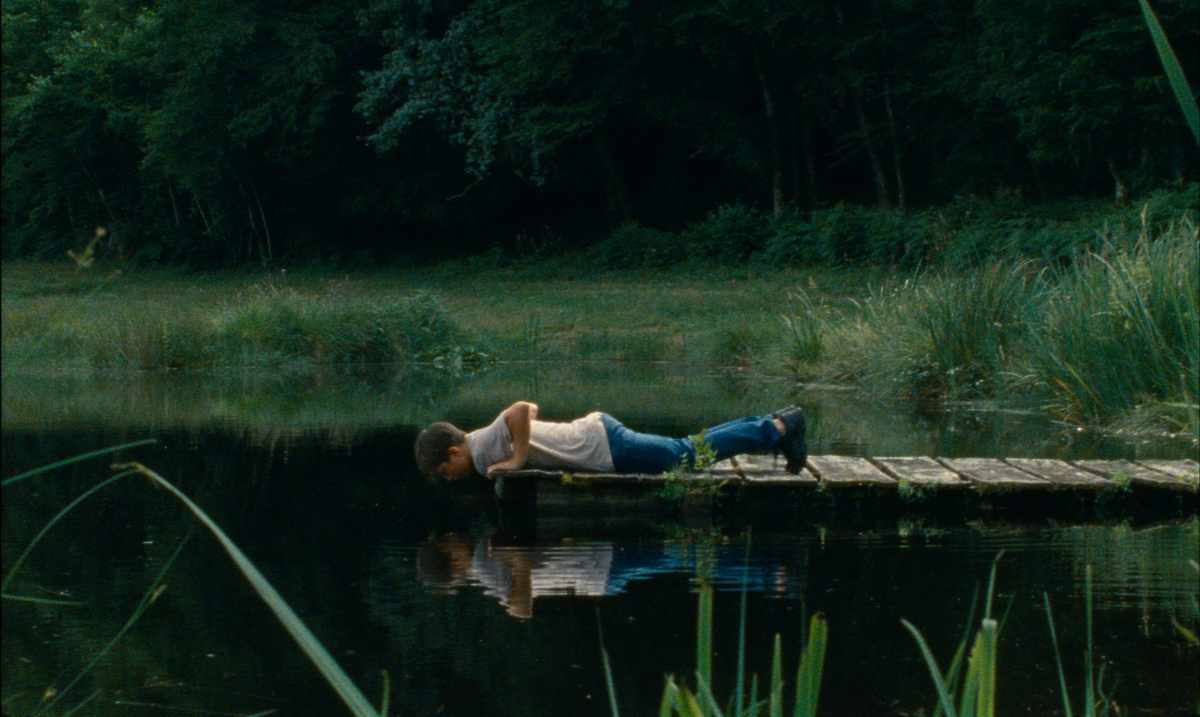Samuel, the main character in David Depesseville’s Astrakan, is heartbroken. It is possible to tell from the teenager’s sullen face. He is an orphan and his adoptive parents, particularly his dad, treat him badly. That’s why his relationship with Hélène becomes some sort of cozy shelter. The time they spend laughing in her room, exchanging glances at church, and kissing passionately in a bus after a school trip creates a strong bond and a safe attachment for Samuel. Those scenes are filled with natural light that warms the frame. So, when he watches Hélène flirting with another guy, it feels like a punch in the stomach. What happened to them? A few sequences later, right after another traumatic event, Samuel will vomit and shit himself. This summarizes the bodily quality that Depesseville’s rural French coming-of-age story has. The frontality with which the director addresses the emotions of growing-up is noteworthy. These emotions find their way out even if it is scatological and they will physically register as such, because growing up has to do with the body: growing up toughens the skin.
Clothes—or the lack thereof—are very relevant in the film, particularly underwear. When someone removes their garments, the skin is in direct contact with the world: it’s exposed as it could be. In this exposure, the body can face many possible, even contradictory, feelings. In one sequence, Hélène and Samuel are in her room and she takes her shirt off in hopes of seducing him but claiming that it’s because of the hot weather. The girl asks Samuel to do the same. Timidly, the boy comes close to her and does what she asks for. The wind shakes the curtains, and the sunlight enters softly into the frame setting a warm environment for a candid first sexual encounter. Suddenly, Hélène’s dad enters the room even though he is never in the house. The man takes Samuel to his stepdad who beats the kid for punishment. There’s a small gap between the experience of pleasure and that of pain.
Later, Samuel and his stepbrothers are playing in a boat. The rope that joins it to the bank gets untied. This is shown in a long close-up where the accident is highlighted, providing the moment with symbolism. The knot that keeps the boat from sailing is the dependence of a child to an adult: a stability that keeps you safe from the possibility of drowning. So, when it gets loose, they are separated from a solid ground to float in open water with the risk of sinking. They pass the threshold to become adults. This becomes more evident when they ask a man on the coast for help who deliberately ignores them. That’s the moment when one of the stepbrothers takes off his undershirt and dives into the water to bring the boat back. The gesture portrays this new unfamiliar stage in the characters’ lives.
Astrakan, then, is about bodily responses to life’s experiences. And, of course, Samuel’s body, his gestures, reactions, and odors are prominent. In this regard, it is not surprising that the boy practices gymnastics. This discipline demands strength and flexibility. The shots’ compositions where he is shown doing the bars create frames within the frame that highlight Samuel’s efforts to be stronger. However, in Depeseville’s view, the bodies are not portrayed in an idealistic way. Their fluids and bad odors are emphasized too. For example, a group of boys bullies Samuel. His reaction is to blow at them so they can smell his bad breath, as if he was a skunk defending itself. Unexpectedly, Hélène tells Samuel that she loves how his breath smell. This comment reveals something about the nature of preferences: there is no good or bad when it comes to how the body looks, smells, sounds or tastes. This idea is brutal in that it banishes the sense of right or wrong in order to advocate for things as they are.
Samuel’s expressions are also crucial in the film. Whenever he smiles there’s a lot of tenderness. When he and Hélène are lying in bed, the girl tells him that she loves it when he smiles because it seems as if he were opening to the world. There, the camera starts to track in. The teenagers disappear out of the frame, as they begin to laugh. That is, in this moment, we don’t get to see the smile the girl just mentioned. Instead, a tree in the distance, framed by the window, in a close-up. The flow of that dialogue, the giggles out of frame, and the camera movement express the possibilities of smile and laughter: a smile can grow into a tree. The transformation in the framing anticipates the final sequence and summarizes the metaphysical touch of this film. Ultimately, Depesseville’s film achieves in blending sweetness and ache, tenderness and cruelty; in sum, the world’s contradictions.
